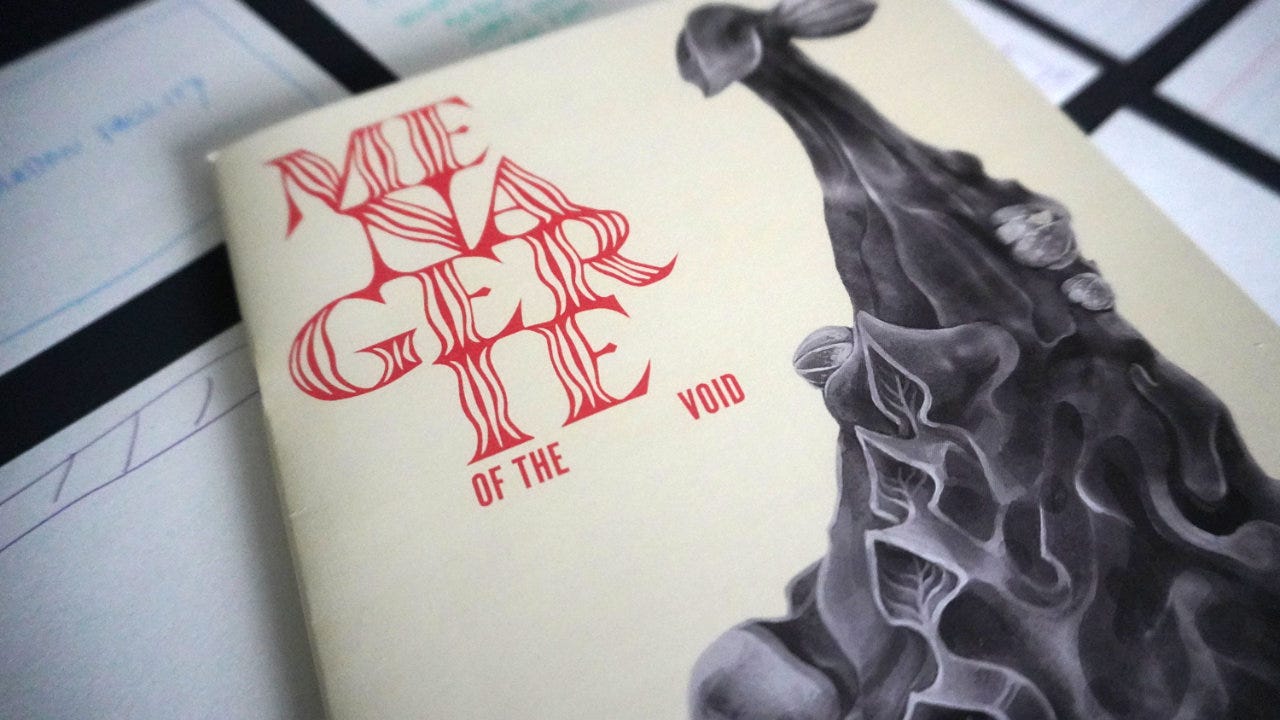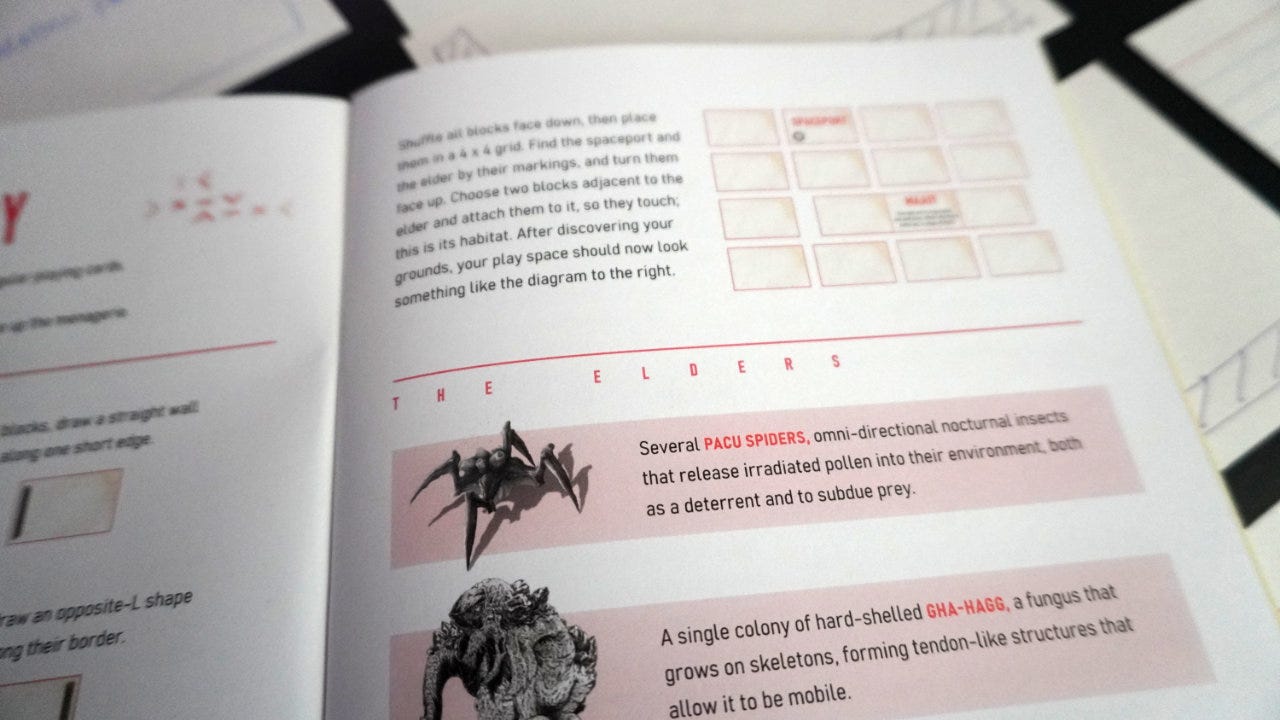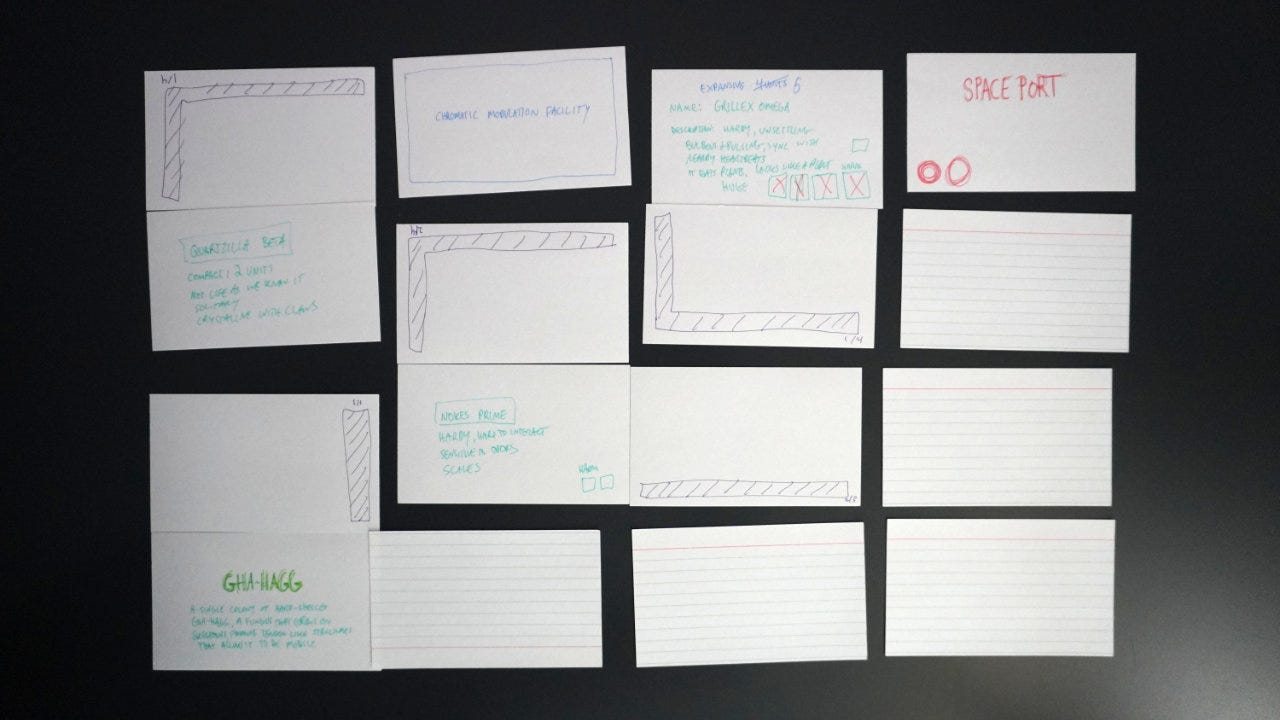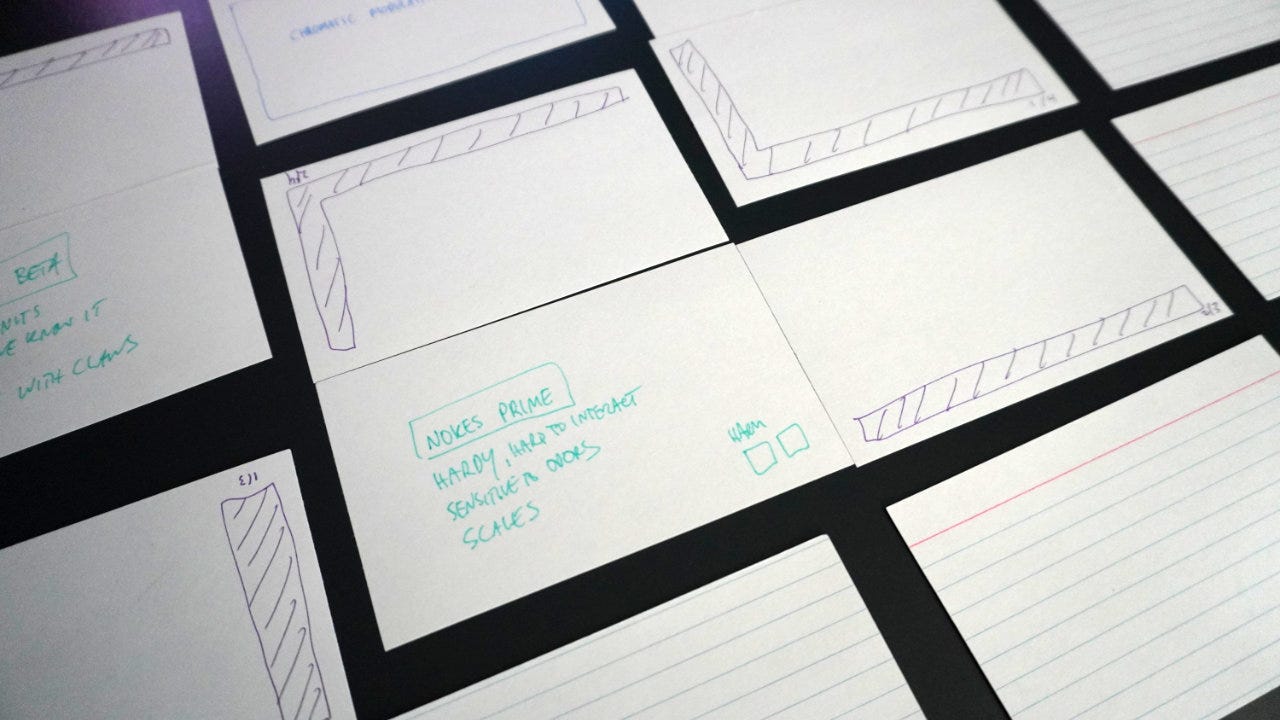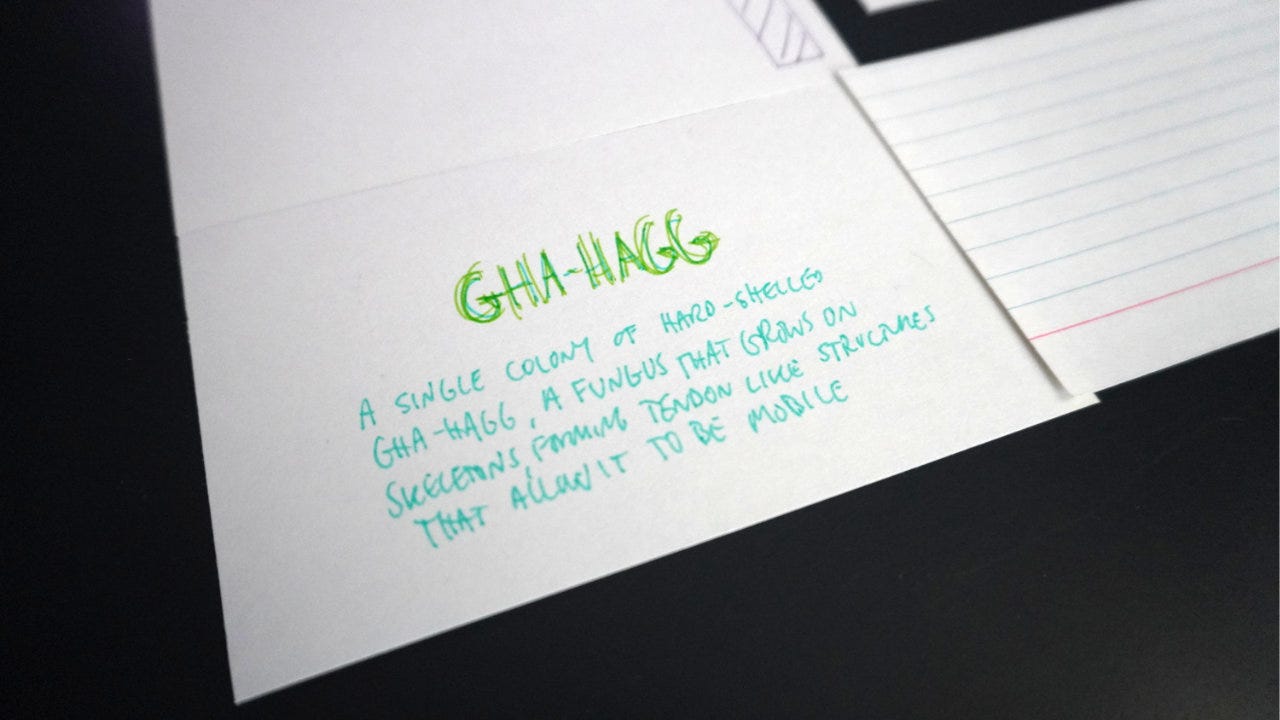SMOOSH JUICE
Not my space zoo. Not my alien monkeys.

Welcome to Skeleton Code Machine, an ENNIE-nominated and award-winning weekly publication that explores tabletop game mechanisms. Check out Public Domain Art and Fragile Games to get started. Subscribe to TUMULUS to get more design inspiration delivered to your door each quarter!
The last two weeks we looked at lessons learned at Unpub 2025:
-
10 questions to ask playtesters (and 3 to avoid)
-
What I learned from 4 panels at Unpub at Exeunt Omnes
This week we are returning to indie roleplaying games and exploring how Menagerie uses cards to create an interstellar zoo.
But first…
I’m teaching a free Make Your Own One-Page Tabletop Game in-person class at Bosler Memorial Library!1 It is four evening sessions starting on Thursday, May 17, 2025. Using the Make Your Own One-Page RPG guide as a framework, I’ll cover everything from initial concept to publishing online. The class is limited to 25 participants. Register online: Bosler Memorial Library CILL.
I picked up Menagerie of the Void by Eran Aviram during a recent trip to FARBO Co in Lancaster. The game begins with you on a faster-than-light spaceship when something goes wrong. Next thing you know, a cybernetic module is implanted in your brain and you are trapped inside a space zoo:
“You play as the keeper of an ancient menagerie created by a long-gone society and sustained by their ancient constructs. These automatic machines do most of the work, but they require a sentient zookeeper to make some of the decisions — and you were selected to do just that.”
This dice-less, solo journaling game requires some index cards and a deck of regular playing cards. The core game loop is pretty straightforward:
You set up your zoo as a grid of index cards, add new creatures, and then some problems happen (e.g. overgrowing organisms, malfunctioning systems). You take an action to try to fix it (e.g. shift blocks). Some creatures might become distressed. This continues until all hope is lost or you achieve full control of the system.
There’s a note in the front of Menagerie that says “this plays on similar vibes to those of The Wretched or Mothership, but you manage a sad zoo.” This should be a clue that the game will usually end in failure.
The way the zoo is built is particularly interesting. You begin by drawing some standard wall shapes on index cards: 3x long edge, 3x short edge, 4x L-shape left, 4x L-shape right. You also create a Spaceport card and an Elder (starting exhibit) card, which are marked with dots on the back.
The cards are shuffled and placed in a 4×4 grid. The dots on the Spaceport and Elder allow you to identify and flip the cards so they are visible.
All future exhibits (i.e. creature habitats) must have at least one block (i.e. index card) adjacent to the Spaceport or an existing exhibit. In addition, the need to have enough contiguous space to thrive — most require 3 blocks. The walls (i.e. the ones drawn on the index cards during setup) partition the areas and break up the spaces.
Index cards are kept face down until a new habitat is being created.
The new habitat cards are pushed together to form an enclosure, indicating that they are a single unit.
While it is common for indie TTRPGs to use index cards as part of the game, I haven’t played as many that use them as tiles. All the wall cards in Menagerie are created at the start of the game during setup, and then remain as hidden information until a new exhibit is created. Only then are three cards flipped face up to reveal the walls — one is replaced with the creature card and one may be rotated.
This creates an interesting tile placement puzzle to be solved. You can only shift one block when creating a habitat (rotate or swap). You can’t attach a block if it has a wall on that side. Exhibits that have less than the number of blocks required for a particular creature generate distress and harm.
Without a hand of cards to use or the ability to draft cards, the player agency is limited when compared to other classic tile placement games such as Carcassonne (Wrede, 2000) or The Castles of Burgundy (Feld, 2011).2 Still, Menagerie uses this mechanism to great effect, providing much more choice than some Carta SRD implementations.
Thinking about how Menagerie uses cards reminded me of how much information is stored in a deck of cards. For example, beyond the rank and suit of standard playing cards, the suit color, position on the table, face up/down, touching or covering cards, and deck size all can be used to increase how much information is stored.
Menagerie’s use of index cards is an example of this:
-
Main card face: Wall locations, creature details, special event information such as when new facilities are created
-
Reverse / card backs: Most cards are blank on the back but the two starting cards have dots on them, allowing them to be flipped face up during setup even though all the cards have been shuffled.
-
Grid position: The 4×4 grid enforces structure to the zoo and restricts where new exhibits can be placed. Events can also destroy cards or rearrange them.
-
Shift to adjacent: Cards are slightly shifted so that they touch to show that they are part of an enclosure. This is a simple way to accomplish this and allows for easy changes in the future if events require it.
The ability to use DIY components in creative ways is one of my favorite things about indie game zines. It’s easy to see that it is the limitations of the format that spark such creativity in how components are used!
Some things to think about:
-
Index cards are flexible: Most people who play indie games have access to dice, pens, pencils, decks of cards, and also index cards. Making a deck of 16 custom index cards and shuffling them isn’t too bad of a setup task, and allows for some interesting mechanisms.
-
Think of components as information storage: Index cards can communicate more information than just what is written on them. Don’t forget about position, facing, and other ways to increase how much info they store. The same can be done with dice.
-
Ambiguous endings are allowed: The end game conditions of Menagerie are intentionally a bit vague: “Once you no longer have the strength to continue, when you can’t see a point to keep enduring, you can stop.” Even the “victory” of gaining full control is ambiguous and that’s OK!
Have you seen interesting uses of index cards in TTRPGs? Share them in the comments!
— E.P. 💀
P.S. Want more game design inspiration? Subscribe to Tumulus to get a print-only zine each quarter from Skeleton Code Machine. 🩻
Skeleton Code Machine is a production of Exeunt Press. All previous posts are in the Archive on the web. Subscribe to TUMULUS to get more design inspiration. If you want to see what else is happening at Exeunt Press, check out the Exeunt Omnes newsletter.



